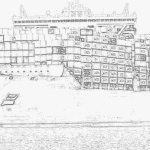The present paper discusses the work of two most prominent South Asian born writers – Rohinton Mistry and Bapsi Sidhwa. The literature produced by these writers is community specific. Rohinton Mistry is an Indian origin Parsi novelist, who later immigrated to Canada. His work shows concern for the marginalised Parsi existence under the impact of modernity and globalisation. His novel ‘Family Matters’ is about the middle class family matters of a Parsi family living in Bombay. It carries theme of immigration, alienation, communal disharmony etc. The other writer is Pakistani Novelist Bapsi Sidhwa who later moved to US. Bapsi Sidhwa’s Crow Eaters is about the Parsi community. In this novel, she writes about Parsi community, their customs, their social behaviour, their thoughts, their traditions and rituals. She tries to analyse the Parsi world view from a new perspective. She belongs to India, Pakistan and USA. Both the writers work focus on the interaction of Parsi community with the Indians, Americans, or Canadians. I will try to find out, how both the witters interpret and challenge the Parsi worldview.
The work of South Asian Writers is sensitive to the various anxieties felt by members of their community. If a writer belongs to minority group, he/ she create an imaginary world which carries problem of his/her ethnic group. Parsis have faced tuff situations where they had to maintain their own cultural identity as well as merged with native culture in order to avoid cultural clash. Parsis do experience ethnic anxieties. They feel insecure, experience identity crisis and threat from dominant culture. They are insecure about decline in population, urbanistaion, globalisation and alienation. Bapsi deals with ethnicity of a settler in an adopted land. She brings up issues of being native and non-native. Both Sidhwa and Mistry have greatly contributed to the development of Parsi literature. Their work is an attempt to create a world full of humility, mutual trust and human understanding. In this research paper I will analyse, compare and review their work with respect to the cultural conflict in the movement and migration of the Parsis, problems of survival in cultural milieu etc.
Introduction
Parsis migrated from Persia to India in 7th century AD. They first settled in Sanjan and later spread to Bombay and many other parts of India. They had to face many challenges to adopt and assimilate in alien land. They even faced cultural extinction. Parsi writers desired to write on valuable themes of ethnic anxiety and cultural adaptability. Rohinton Mistry and Bapsi Sidhwa are two such Parsi immigrant novelists writing in English. The literature introduced by Parsi writers is characterised by minority discourse. Being the minority in India, the Parsis do experience ethnic anxieties. They feel insecure and threatened by chances of possible submersion into the dominant culture.
The word ‘Ethnic’ was derived in 14th century as a noun and in 15th century as an adjective meaning heathen; from Greek word “ethnos” which means nation. According to CHAMBERS 21st century Dictionary, “Ethnic” is relating to or having common race or cultural tradition. It is associated with an exotic, especially non-european, racial or tribal group. The other definition which is given by Oxford Advanced Learner’s Dictionary defines the term Ethnic as a) connected with or belonging to a nation, race or people that shares a cultural tradition b) Typical of a country or culture that is very different from modern western culture and therefore interesting for people in western countries.
Anxieties are resulting out of ethnicities. Parsis residing in India, Pakistan and in the western countries are in minorities as per their demographic decline and also due to their subjection or dominance by the dominant cultures like Hindu, Islam and Christian respectively. Thus, Parsis are ethnic minority. Ajay Sahebrao Deshmukh in his book Ethnic Angst says that “Whenever any culture or ethnic group or civilization has an advantage over all others, whether culturally or politically, their programs of self glorification have usually directed to destruction of not just that ethnic group or civilization but also that of the other who have been drawn into the whirlpool of mass obliteration.” (Deshmukh) Ethnic anxieties arise in the excise of power. The clash of two different ethnic groups causes ethnic anxieties. The threatening aspect of the majority community is that it causes economic and social backwardness of minority communities. These threats which are connected to economic or social existence can even lead to insecure religious identity.
“Parsis migrated to India after Arab onslaught in search of a safe place to reside. But in India, they were given conditional refuge . . . Being a minority group, they agreed on all specified conditions. Consequently faced the problems related to migration and adjustment with the new land”(23). In the process of transcending the boundaries of nations, cultures result into multiplicity, hybridity and complete loss of self identity. Parsis have experienced trauma of “otherness”. Some of the factors held responsible for declining Parsi community in the world are: urbanization, late marriages, and non acceptance of the children of Parsi women marrying outside the community.
Culture identity has become the major issue in the multicultural nations. The cultural clash arises in multiethnic nation because the dominant culture is reluctant to absorb the immigrant cultures. The individual and families, who live in juncture of two cultures, can accommodate both cultures. But being born in one culture and living in the second, they are considered as marginal people because of being different from the norm set by majority. Marginalisation in any culture is what is not major, not central and not powerful. That is just subordinate. Issues like exile, rootlessness and cultural differences arises due to problem of migration.
Both Sidhwa and Mistry have depicted the way how Parsi interacts with the rest of the world. This paper tries juxtaposing the female-male discourse and presents the marginalisation of Parsi community. Sidhwa’s novel The Crow Eaters talks about the Parsi community and their movement and migration to the UK, and their effort to be like British. On the other side, Mistry’s novel ‘Family Matters’ is about the middle class family matters of a Parsi family living in Bombay. It carries theme of immigration, alienation, communal disharmony etc. Their works are expression of Parsi sensibility and sense of belongingness.
Bapsi Sidhwa’s The Crow Eaters
Bapsi Sidhwa belongs to India, Pakistan and United Nation. She likes to be called as a Punjabi-Pakistani-Parsi woman. She started writing at the age of twenty six, like many other unknown writers. Bapsi Sidhwa was born in an eminent Parsi family of Karachi in 1939. Her first two novels The Bride and The Crow Eaters bought her recognisation. She is one of the most promising English novelists from South Asia. She was awarded the Sitara-i-Imtiaz by the government of Pakistan and the National award for English literature by the Pakistan Academy of Letters in 1991. She is the first English writer in Pakistan to receive international acclaim.
She is a prominent writer of diaspora of Pakistan. As a writer of Parsi origin, Sidhwa deals with ethnic identity. She has talked about the problems of being native of an alien land and suffering identity crisis. She has taken up the issue of cultural differences and also discussed problems arising out of it in her novel The Crow Eaters. Randhir Pratap Singh in his book Bapsi Sidhwa concludes “The Crow Eaters has influenced not only a new generation of Parsi writers but also many Indian and Pakistani writers who are introducing Parsi characters in their work more freely”(Singh 86).
Sidhwa writes about the Parsi community because she is born into that community and knows about beliefs, customs and psyche of people belonging to her community. Bapsi Sidhwa in her novel “The Crow Eaters” has given information about the customs, ceremonies, beliefs, superstitions, rites, rituals, myth, legends and various other aspects related to Parsi life. Overall, she has tried to show a different aspect of Parsis life in her novel. She tries to familiarise the non parsi world with the parsis ways of life, their faith and values. She is successful in preserving Parsi community way of life and traditions through her literary works. She says “Because of a deep rooted admiration for my diminishing community – and an enormous affection for it – this work of fiction has been a labour of love”(Sidhwa) This is her first novel which reveals the Parsi community achievements like despite being a tiny community, it has managed to survive and prosper without losing identity.
In the novel The Crow Eaters, the title refers to the crow which symbolises high pitched garrulousness of the Parsis. It was the limited status of a minority community like Parsis which forced them to pay homage to the Britishers. The main protagonist Fardeeon’s views represent Parsi compromise as they were loyal to land they inhabit and adopt whichever culture. Faredoon Junglewalla leaves his ancestral village in the central India, with his wife Putli, mother-in-law Jerbanoo and infant daughter Hutoxi to seek fortune in the pastures of Punjab. Faredoon has ultimate aim to get wealth and status. He is ambitious and influential man. Sidhwa has presented the marginal personality aspect within the Parsi milieu. The Paris wanted to gain protection from the ruling British authority by being loyal to them. This is exactly what is conveyed in this novel. Freddy took every opportunity to demonstrate his loyalty to Britishers. Loyalty and faithfulness towards the ruler is a feature of Parsis.
The Crow Eater is a study of Parsi value systems and customs. Parsis are strict follower of religious teachings, which can be seen through characters of Putli and Jerbanoo. Sidhwa’s works depict the Parsi identity through traditional dress or costumes. It can be noticed that Faredoon and his family took pride in their traditional costumes but the new generation of Parsis like Behram and Tanya discarded it. Bapsi has also portrayed the changing generations in the Junglewala family. For example the new generation becomes increasingly westernised.
Rohinton Mistry’s Family Matters
Rohinton Mistry’s novels are concerned with Parsis existence in India. He represents his community through different narratives of his characters. The characters express their views on the changes that affect them. He tries to throw light on the existing facts. He shows the marginalised existence of Parsis which is threatened by the impact of modernity. The ethnic anxiety is best exposed in novels of Mistry.
Rohinton Mistry’s novel “Family Matters” which was published in 2002 represents the Parsis, a minority community through the lives of the characters. It is the third novel written by Mistry. Family Matters is about the middle class family matters of a Parsi family of Bombay, during post Babri Masjid demolition period in 90’s. This novel deals with issues like cosmopolitan city life, communalism, immigration, belongingness etc. It presents longing for home and problem of homelessness. It is story of a retried Parsi professor living with his two step children Jal and Harsh along with arrogant daughter Coomy. In the novel, all the major characters have a roof and shelter but still have feeling of homelessness due to lack of proper emotional attachment within the family. It also shows that parsis emigrate to foreign countries for monetary security.
Mistry’s “Family Matters” is the story of Nariman Vakeel who is haunted by past memories. Through the narration of domestic crisis in one middle class family, Mistry tries to reach the problem of Indian Parsis as marginalised community. For Mistry, ideal family is formed with care, solidarity and humanity. The theme of suffering, belongingness and up rootedness is treated through character of Nariman who suffers from various diseases. He has to depend on his step children’s for smooth functioning of his life. His late wife’s daughter Cooney wishes that Roxanna who is only natural child of Nariman should take care of his father. This discloses reality of family life and its politics.
Mistry shows concern for marginalised Parsis by narrating incidents of late marriages, prohibition of inter caste marriages, generation gap, low birth rate etc. He has presented generational gap through character of Yezad who opposes his sons Jehangir and Murad for being secular, westernised and eager to marry a non-parsi girl.“Like other Parsi writers Mistry is sensitive to the various anxieties felt in his community. He has demonstrated this by responding to the existing threats to the Parsi family and community in particular and also to the country in general.” (44) Mistry’s Family Matters centres the merit and notions of ethnic purity. The main concern of vulnerable Parsi community is ethnic purity. For example, Nariman hold up the values and purity of his community as he marries a 40 years old Parsi widow with two children. He surrenders his personal fondness in preference to his community consciousness. Next is Yezad who is also concerned with purity of unique and ancient Persian community. Mistry has deliberately talked about the love affairs of grandfather and grandson with a non-parsi girl.
The novel raise several critical issues i.e. decline in population, inter communal marriages, low birth rate, high death rate etc. The character of Dr. Fitter shares the grief and concern over the future of Parsi population. He says “Extinct, like dinosaurs,” “They‘ll have to study our bones that are all” (Mistry 400). All the characters face identity crisis and struggle individually but Nariman suffers maximum. Misty tries to show how identifying with others, who share common roots and similar dilemmas can help in overcoming feelings of victimization, avoid sense of failure, generate consciousness and self reflection.
Comparison & Conclusions
The work of South Asian Writers is sensitive to the various anxieties felt by members of their community. There are differences in emphasis and focus of South Asian men and women writers. South Asian women writers have been ‘doubly othered’, first as the colonised and then as women. Therefore, their work is inspired to break silence to retell tales and raise point of view. South Asian women writers like Bapsi Sidhwa have written much about family and community. They are making use of circumstances to which they are well familiar as a source for their writing.
Bapsi Sidhwa and Rohinton Mistry belong to two different geographical locations, Pakistan and India respectively. But share the common element of religion and culture. They both focus on problems faced by their microscopic community i.e. problem of survival. Both the writers have written at different point of time. They both are sensitive to their community’s aspirations and fears, struggle for survival and identity crisis.
In her novel The Crow Eaters, Sidhwa shows the Parsi lifestyle, their beliefs, traditions and ethos. She has shown different aspect of Parsi way of life. She has written this novel to pay her regard for the Parsi community which is on verge of extinction. Jaydipsinh Dodiya in his book Parsi English Novel notes “The authenticity of Bapsi Sidhwa’s work is evident in depicting the real experiences of living in Karachi and Lahore where she continues to live” (81). Further, he also comments about Mistry’s writing. He says that ‘Mistry likes to write about India, which engages his imagination. Living in Canada and writing about India Mistry is fully aware of several drawbacks of India’s social and political life, as is discernible in his novels’ (44). In his novel “Family Matters”, Mistry deals with wide range of issues such as generation gap, familial bondage, human relationships, immigration, alienation, sense of belongingness, suffering and death.
Both Sidhwa and Mistry have greatly contributed to the development of Parsi literature. They have different outlook but their work is an attempt to create a world full of humility, mutual trust and human understanding. Both the writers have interpreted the community’s self centeredness, its obsession with differences, its isolation, its fear of degeneration etc. They attempt to raise concerns and stop the rapid decline in Parsi population. They have empowered their community through work which focuses on their anxieties, problems, clashes, concerns etc.
References
Deshmukh, Ajay Sahebrao. Ethnic Angst: A Comparative study of Bapsi Sidhwa & Rohinton Mistry. Patridge India, 2014. print.
Dodiya, Jaydipsinh. Parsi English Novel. Delhi: Sarup& Sons, 2006. Print.
—. Parsi English Novel. Delhi: Sarup & Sons, 2006. Print.
Mistry, Rohinton. Family Matters. London: Faber and Faber Limited, 2002. Print.
Sidhwa, Bapsi. The Crow Eaters. Delhi: Penguin Books, 1980. Print.
Singh, Randhir Pratap. Bapsi Sidhwa. Delhi: IVY Publishing House, 2005. Print.
Indian Review | Authors | Indu Pandey writes for Indian Review.






Leave a Reply